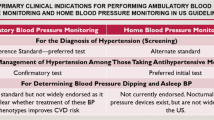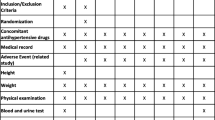Abstract
Introduction
The use of unattended automated office blood pressure (uAutoOBP) versus attended automated (aAutoOBP) and manual auscultatory office blood pressure (AuscOBP) measurements is a topic of current controversy.
Aim
To evaluate the differences between OBP measurements methods in the general practice (GP) setting.
Methods
We first compared aAutoOBP and uAutoOBP in 42 consecutive patients with hypertension (group 1). Secondly, we compared AuscOBP to uAutoOBP measurements in 133 consecutive patients with hypertension (group 2). In addition, we analyzed the achieved OBP targets as recommended in the 2018 European Society of Cardiology (ESC) and the European Society of Hypertension (ESH) guidelines in group 2.
Results
The mean age of patients in group 1 was 71 years (range 34–89 years, 54.8% females). The aAutoOBP and uAutoOBP systolic (131.7 and 131.6 mmHg) and diastolic (83.4 and 82.4 mmHg) mean values were not significantly different. The patient characteristics in group 2 were similar to group 1. We observed a significant difference between AuscOBP and uAutoOBP measurement for both systolic (149.4 versus 129.5 mm Hg) and diastolic (85.4 versus 81.6 mm Hg, p < 0.0001, respectively). Accordingly, 20.3% and 45.9% of patients reached the overall 2018 ESC/ESH systolic and diastolic OBP targets of < 140/80 mmHg according to AuscOBP and uAutoOBP (p < 0.0001).
Conclusion
The attended versus unattended status of automated OBP measurements had no impact on OBP values in GP. However, significantly higher OBP values and lower rates of achieved target OBP were observed by using AuscOBP measurements by physicians in comparison to automated OBP recordings.



Similar content being viewed by others
References
Zhou B, Bentham J, Di Cesare M, Bixby H, Danaei G, Cowan MJ, et al. Worldwide trends in blood pressure from 1975 to 2015: a pooled analysis of 1479 population-based measurement studies with 19.1 million participants. The Lancet. 2017;389(10064):37–55.
Williams B, Mancia G, Spiering W, Agabiti Rosei E, Azizi M, Burnier M, et al. 2018 ESC/ESH guidelines for the management of arterial hypertension. Eur Heart J. 2018;39(33):3021–104.
Paini A, Salvetti M, Bertacchini F, Stassaldi D, Maruelli G, Arnoldi C, et al. Unattended vs attended Bp measurement: mean values and determinants of the difference. J Hypertens. 2018;36:e70.
Group SR. A randomized trial of intensive versus standard blood-pressure control. N Engl J Med. 2015;373(22):2103–16.
Lüscher TF, Kjeldsen SE, Mancia G, Papademetriou V. From ‘essential’ hypertension to intensive blood pressure lowering: the pros and cons of lower target values. Eur Heart J. 2017;38(44):3258–71. https://doi.org/10.1093/eurheartj/ehx643.
Stergiou GS, Kyriakoulis KG, Kollias A. Office blood pressure measurement types: different methodology—different clinical conclusions. J Clin Hypertens. 2018;20(12):1683–5.
Kollias A, Stambolliu E, Kyriakoulis KG, Gravvani A, Stergiou GS. Unattended versus attended automated office blood pressure: systematic review and meta-analysis of studies using the same methodology for both methods. J Clin Hypertens. 2019;21(2):148–55.
Nasothimiou EG, Tzamouranis D, Rarra V, Roussias LG, Stergiou GS. Diagnostic accuracy of home vs. ambulatory blood pressure monitoring in untreated and treated hypertension. Hypertens Res. 2012;35(7):750.
Quer G, Nikzad N, Chieh A, Normand A, Vegreville M, Topol EJ, et al. Home monitoring of blood pressure: short-term changes during serial measurements for 56398 subjects. IEEE J Biomed Health Inf. 2017;22(5):1691–8.
Kjeldsen SE, Mancia G. Unattended automated office vs. ambulatory blood pressure in people with high cardiovascular risk: implications for understanding the SPRINT results. J Hypertens. 2019;37(1):6–8.
Roerecke M, Kaczorowski J, Myers MG. Comparing automated office blood pressure readings with other methods of blood pressure measurement for identifying patients with possible hypertension: a systematic review and meta-analysis. JAMA Internal Med. 2019;179(3):351–62.
Myers MG, Parati G. Self-measurement of blood pressure in the office and at home. J Hypertens. 2003;21(12):2223–5.
Parati G, Pomidossi G, Casadei R, Mancia G. Lack of alerting reactions to intermittent cuff inflations during noninvasive blood pressure monitoring. Hypertension. 1985;7(4):597–601.
Myers MG, Godwin M, Dawes M, Kiss A, Tobe SW, Grant FC, et al. Conventional versus automated measurement of blood pressure in primary care patients with systolic hypertension: randomised parallel design controlled trial. BMJ. 2011;342:d286.
Mancia G, Bombelli M, Cuspidi C, Facchetti R, Grassi G. Cardiovascular risk associated with white-coat hypertension: pro side of the argument. Hypertension. 2017;70(4):668–75.
Mancia G, Parati G, Pomidossi G, Grassi G, Casadei R, Zanchetti A. Alerting reaction and rise in blood pressure during measurement by physician and nurse. Hypertension. 1987;9(2):209–15.
Franklin SS, Thijs L, Asayama K, Li Y, Hansen TW, Boggia J, et al. The cardiovascular risk of white-coat hypertension. J Am Coll Cardiol. 2016;68(19):2033–43.
Mancia G, Zanchetti A. Editors’ Corner: White-coat hypertension: misnomers, misconceptions and misunderstandings. What should we do. J Hypertens. 1996;14(9):1049–52.
Parati G, Omboni S, Staessen J, Thijs L, Fagard R, Ulian L, et al. Limitations of the difference between clinic and daytime blood pressure as a surrogate measure of the ‘white-coat’effect. J Hypertens. 1998;16(1):23–9.
Whelton PK, Carey RM, Aronow WS, Casey DE, Collins KJ, Himmelfarb CD, et al. 2017 ACC/AHA/AAPA/ABC/ACPM/AGS/APhA/ASH/ASPC/NMA/PCNA guideline for the prevention, detection, evaluation, and management of high blood pressure in adults: a report of the American College of Cardiology/American Heart Association Task Force on Clinical Practice Guidelines. J Am Coll Cardiol. 2018;71(19):e127–248.
Bauer F, Seibert FS, Rohn B, Bauer KA, Rolshoven E, Babel N, et al. Attended versus unattended blood pressure measurement in a real life setting. Hypertension. 2018;71(2):243–9.
Filipovský J, Seidlerová J, Kratochvíl Z, Karnosová P, Hronová M, Mayer O Jr. Automated compared to manual office blood pressure and to home blood pressure in hypertensive patients. Blood Press. 2016;25(4):228–34.
Filipovský J, Seidlerová J, Ceral J, Vysočanová P, Špác J, Souček M, et al. A multicentre study on unattended automated office blood pressure measurement in treated hypertensive patients. Blood Press. 2018;27(4):188–93.
Wei W, Tölle M, Zidek W, van der Giet M. Validation of the mobil-O-Graph: 24 h-blood pressure measurement device. Blood Pressure Monit. 2010;15(4):225–8.
Weiss W, Gohlisch C, Harsch-Gladisch C, Tölle M, Zidek W, van der Giet M. Oscillometric estimation of central blood pressure: validation of the Mobil-O-Graph in comparison with the SphygmoCor device. Blood Pressure Monit. 2012;17(3):128–31.
Brinker S, Pandey A, Ayers C, Price A, Raheja P, Arbique D, et al. Therapeutic drug monitoring facilitates blood pressure control in resistant hypertension. J Am Coll Cardiol. 2014;63(8):834–5.
James PA, Oparil S, Carter BL, Cushman WC, Dennison-Himmelfarb C, Handler J, et al. 2014 evidence-based guideline for the management of high blood pressure in adults: report from the panel members appointed to the Eighth Joint National Committee (JNC 8). JAMA. 2014;311(5):507–20.
Handler J. The importance of accurate blood pressure measurement. Permanente J. 2009;13(3):51.
Andreadis EA, Geladari CV, Angelopoulos ET, Savva FS, Georgantoni AI, Papademetriou V. Attended and unattended automated office blood pressure measurements have better agreement with ambulatory monitoring than conventional office readings. J Am Heart Assoc. 2018;7(8):e008994.
Irving G, Neves AL, Dambha-Miller H, Oishi A, Tagashira H, Verho A, et al. International variations in primary care physician consultation time: a systematic review of 67 countries. BMJ Open. 2017;7(10):e017902. https://doi.org/10.1136/bmjopen-2017-017902.
Acknowledgements
We are very grateful for the outstanding support of the entire staff of the Audorfer Gemeinshaftspraxis.
Author information
Authors and Affiliations
Corresponding author
Ethics declarations
Conflict of interest
The authors declare that they have no conflict of interest.
Ethical approval
The protocol was in accordance with the 1975 Helsinki Declaration and approved by the Charité ethics committee.
Informed consent
Informed consent was obtained from all participants before inclusion into the study.
Electronic supplementary material
Below is the link to the electronic supplementary material.
Rights and permissions
About this article
Cite this article
Höller, J., Villagomez Fuentes, L.E., Matthias, K. et al. The Impact of Measurement Methods on Office Blood Pressure and Management of Hypertension in General Practice. High Blood Press Cardiovasc Prev 26, 483–491 (2019). https://doi.org/10.1007/s40292-019-00347-z
Received:
Accepted:
Published:
Issue Date:
DOI: https://doi.org/10.1007/s40292-019-00347-z




